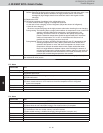
5
5 - 24
4. W-2WAY ECO-i Alarm Codes
W-2WAY ECO-i SYSTEM
Trouble Diagnosis
P04 Alarm
Alarm code P04
Alarm meaning High-pressure switch activated.
Alarm conditions The operation of the electronic circuit in the high-pressure switch may short-circuit the terminal
depending on the pressure. A pressure of 478.6 psi or above will short-circuit the terminal. Once
the terminal is short-circuited, it will remain in that state until the pressure goes below 377.1 psi.
Probable cause (1) Failure of the check valve in the compressor discharge tube.
(2) The service valve is closed.
(3) Clogging of the outdoor heat exchanger during cooling.
(4) An air short in the outdoor unit during cooling.
(5) Failure of the outdoor fan during cooling.
(6) Clogging of the air filter in the indoor unit during heating.
(7) An air short in the indoor unit during heating.
(8) Failure of the indoor fan during heating.
(9) Clogging of the refrigerant circuit.
(10) Failure of the mechanical valve.
(11) Failure of the solenoid valve kit.
(12) Too much refrigerant has been charged.
(13) Failure of the high-pressure switch.
Check (1) Make sure that the high-pressure switch connector has been properly connected.
(2) If the high-pressure switch is properly connected, connect a high-pressure gauge to the
high-pressure outlet port and monitor the pressure during operation to check the pressure
when the high-pressure switch is activated. Check valve failure is likely if the pressure is less
than 478.6 psi. The following describes checks to be made when the pressure is high.
(3) During cooling, check whether the outdoor unit heat exchanger is clogged. Remove any
foreign material that prevents ventilation.
(4)
During cooling, check whether an air short blockage has occurred in the outdoor unit. The
system is operating normally unless the temperature around the outdoor unit is excessively high.
(5) During cooling, check for outdoor fan failure. Check whether the screws securing the fan are
loose and whether the fan connector in the outdoor unit PCB is properly connected.
(6) During heating, check whether the air filters in the indoor unit are clogged. If clogged, clean
the filters.
(7) During heating, check whether an air short blockage has occurred in the indoor unit. The
system operates normally unless the temperature around the indoor unit is excessively high.
(8) During heating, check for indoor fan failure.
(9) Check whether the refrigerant circuit is clogged. Check that all service valves are closed.
Check whether welded locations are clogged.
(10) Check for mechanical valve failure. Check whether the mechanical valves make a clattering
sound when the power is reset. Since the mechanical valve in the indoor unit is in a location
that makes aural inspection difficult, use an electric means to check. Check that the
connector pin of the mechanical valve on the PCB outputs 4 V. In addition, check that the coil
resistance of the mechanical valve is several tens of Ohm (
Ω)
.
(11) Check for solenoid valve kit failure. Removing a coil that is on will result in a clicking sound.
Also, removing a coil that is off will not produce such a sound.
(12) Check whether too much refrigerant has been charged. Too much refrigerant has been
charged if the sub-cool temperature of the condenser is 59°F or more.
Correction Replace damaged components and correct the amount of charged refrigerant.
Example —
Notes —
P05 Alarm
Alarm code P05
Alarm meaning Reverse phase (or missing phase) detected
Alarm conditions This alarm occurs when a reverse phase or missing phase is detected in the L1-L2-L3-N phases.
Probable cause Reverse phase or missing phase in the L1-L2-L3-N phases
Check Check the wiring at the power terminal plate.
Correction Switch the phases and reinsert. Check if the result is OK.
Example —
Notes —


















